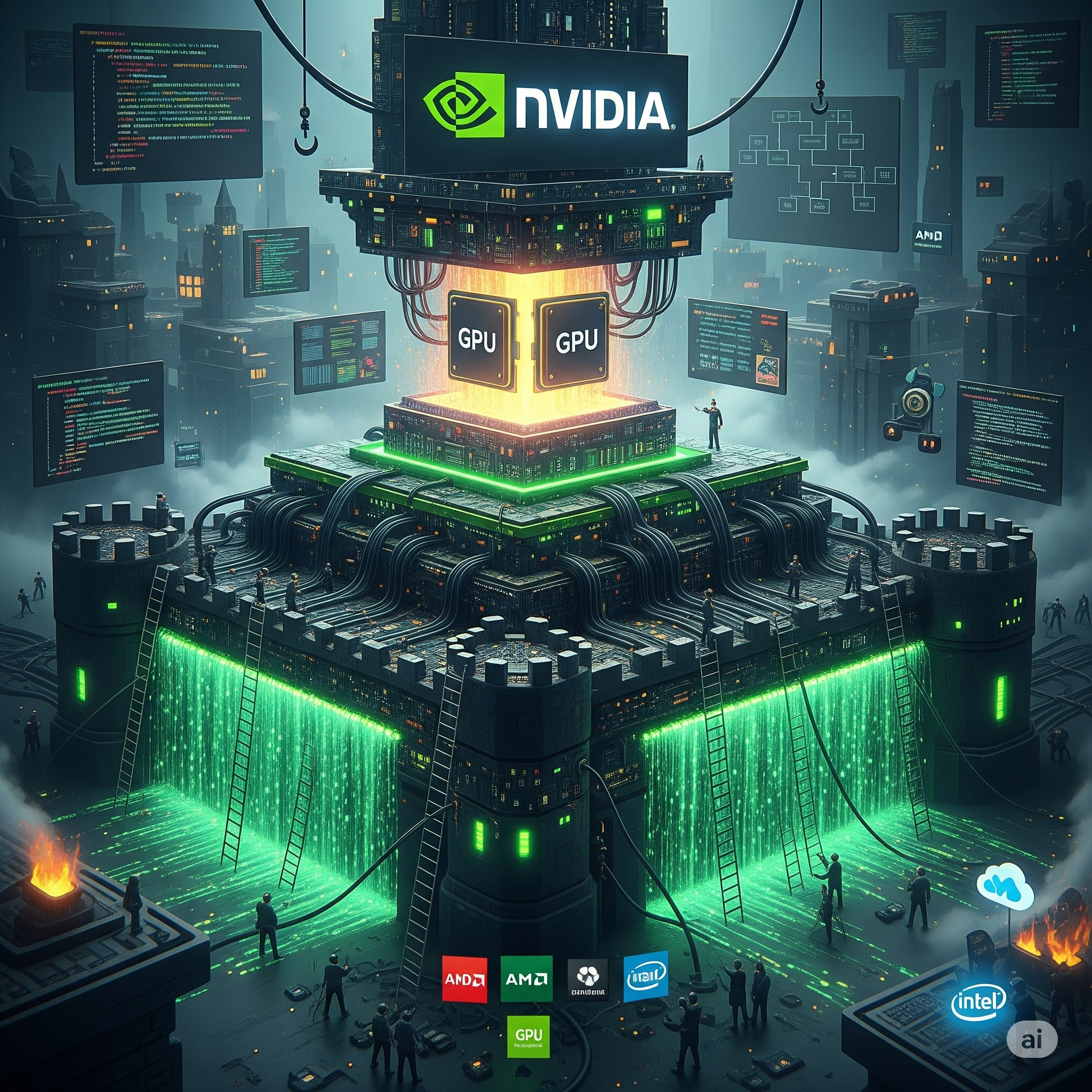Why NVIDIA's AI Dominance Isn't Just About Better Chips

Most people think NVIDIA dominates AI because they make the best GPUs. But that’s like saying Microsoft dominated the 90s because they made the best operating system. The real moat is ecosystem lock-in that spans from silicon to software – and it’s actually getting stronger despite hundreds of billions in investment trying to break it.
The Software Moat: Death by a Thousand Cuts
NVIDIA’s real advantage isn’t the H100 chip – it’s everything that makes that chip useful. When developers say they’re using “PyTorch” or “TensorFlow,” they’re actually using a massive stack of NVIDIA-specific optimizations:
The development ecosystem creates daily dependencies. Developers rely on Nsight Systems for profiling, CUDA-GDB for debugging GPU kernels, and Visual Profiler for performance analysis. Try debugging a memory leak in a GPU kernel on AMD’s ROCm – the tooling gap is immediately apparent.
The library advantage runs deeper than most realize. cuDNN provides deep learning primitives that are 2-3x faster than alternatives. cuBLAS offers hand-optimized linear algebra for each GPU generation. TensorRT can deliver 5-10x inference speedups. These aren’t just nice-to-haves – they’re the difference between a model that trains in days versus weeks.
The knowledge ecosystem compounds over time. Fifteen years of CUDA documentation, Stack Overflow answers, and university curricula have created millions of developers who know CUDA debugging patterns. When production breaks at 3 AM, you need someone who can actually fix it.
Even when developers think they’re writing “portable” code in PyTorch, they’re making CUDA-specific decisions about memory management (torch.cuda.empty_cache()), mixed precision training for Tensor Cores, and multi-GPU distributed patterns. The abstraction leaks everywhere.
This Is a Solved Problem
Here’s the kicker: this is essentially the same problem Java solved 30 years ago with the JVM. Write once, run anywhere via bytecode and virtual machine abstraction. The GPU/ML ecosystem is slowly converging on similar solutions, but they’re not there yet.
The building blocks exist today. MLIR (Multi-Level Intermediate Representation) provides compiler infrastructure for tensor operations. OpenXLA compiles computation graphs to optimized device code. Triton offers a Python-like language that compiles to GPU kernels across different architectures. ONNX Runtime provides cross-platform optimization.
What’s missing isn’t technical capability – it’s a mature, battle-tested “JVM for ML” that developers can actually rely on in production. The abstraction layer needs to be at the compiler/runtime level, not just the framework level.
The Incentive Misalignment
With hundreds of billions flowing into AI, you’d expect this infrastructure problem to be solved by now. But the money isn’t flowing to the right places because of misaligned incentives:
NVIDIA’s position is obvious – they make more money from lock-in than from portability. Why would they commoditize their own advantage?
Cloud providers face a complex calculation. AWS, Google, and Microsoft could save billions by using cheaper AMD or Intel accelerators. Even a 20% cost reduction on millions of GPU hours equals massive profit improvements. But they’re caught between maximizing margins on current workloads versus potentially cannibalizing their premium GPU offerings.
AI companies are focused on models, not infrastructure tooling. When you’re racing to market with the next breakthrough model, you use whatever hardware you can get your hands on. Infrastructure investments pay off over years, not quarters.
VCs are funding “AI applications” – the flashy stuff that makes headlines – rather than boring compiler infrastructure. It’s like if the entire software industry had billions to spend on applications but refused to invest in operating systems.
The switching cost reality makes the problem worse. Even if perfect portability existed tomorrow, enterprises face massive switching costs. Retraining developers costs $100K+ per engineer. Debugging and profiling toolchain migration means months of productivity loss. Performance regression risk could mean 20-50% slower models without optimized libraries.
The Hidden Moat: Everything Below the GPU
But here’s what most people miss – NVIDIA has been building advantages at every layer below the GPU too, creating a full-stack moat that’s even harder to replicate.
The networking stranglehold is particularly clever. Multi-GPU training requires massive bandwidth between GPUs. NVIDIA’s NVLink provides 600GB/s GPU-to-GPU communication versus PCIe’s ~64GB/s. NVSwitch creates all-to-all GPU connectivity in servers. After acquiring Mellanox for $7B, NVIDIA owns the InfiniBand high-speed datacenter networking stack.
System-level integration means everything is co-designed. Grace CPUs are ARM processors built specifically to pair with NVIDIA GPUs. DGX systems come pre-integrated and pre-optimized. BlueField DPUs handle network and storage offload. The bigger the cluster, the more these advantages compound.
Even cloud providers can’t fully escape. AWS uses custom Nitro networking between nodes but still relies on NVIDIA InfiniBand and NVLink for GPU-to-GPU communication within nodes. Google has custom TPU interconnects for their own chips but GPU instances still need NVIDIA’s intra-node connectivity. Microsoft built SONiC for datacenter networking but uses NVIDIA InfiniBand for high-performance computing clusters.
The result is a hybrid approach where cloud providers control inter-node networking but NVIDIA dominates intra-node networking. This split means NVIDIA gets networking revenue even from cloud providers actively trying to reduce their dependence.
The Path Forward
The next breakthrough won’t come from better chips – it’ll come from whoever builds the “JVM for AI” that actually works in production. The technology exists, but it needs the same level of investment and polish that went into the Java ecosystem.
The question isn’t whether NVIDIA makes the best hardware. It’s whether the AI industry will solve the same portability problem that the software industry solved decades ago, or whether they’ll remain trapped in an ecosystem that’s getting more entrenched with every billion-dollar investment.
The clock is ticking, and the switching costs are only getting higher.